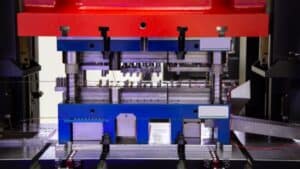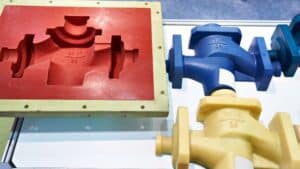What is Conformal Cooling?
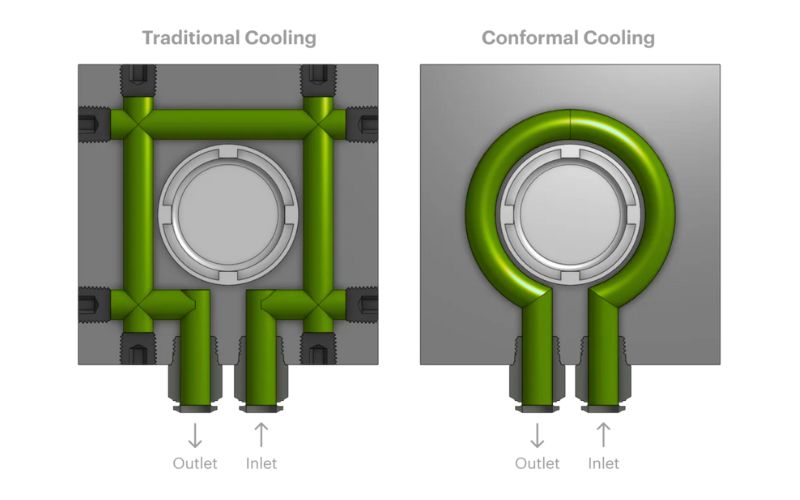
Conformal cooling represents a significant advancement in manufacturing technology, particularly for injection molding processes.
Conformal cooling refers to cooling channels that follow the exact shape or contours of a mold cavity.
Unlike traditional straight-drilled cooling channels, conformal cooling paths maintain a consistent distance from the mold surface throughout the entire tool.
The technology is simple: by following the part’s geometry, heat can be removed more evenly and efficiently.
With conformal cooling, you can achieve more uniform temperature control across complex part geometries that would be impossible with conventional cooling methods.
Benefits of Conformal Cooling in Manufacturing
First, cycle times can be reduced significantly because parts cool mo re quickly and evenly.
Part quality also improves dramatically. You’ll see fewer defects like warping, sink marks, and internal stresses because temperature distribution is more uniform during the cooling phase.
Production efficiency increases as well. Your machines can produce more parts per hour, and you’ll experience fewer rejected parts due to cooling-related defects.
Energy efficiency is another important benefit. Your cooling systems will use less power since they target heat more precisely where needed.
Design and Fabrication
Effective conformal cooling systems requires careful planning and advanced manufacturing methods.
The design of conformal cooling channels starts with analyzing the plastic part’s geometry.
When designing your channels, consider these key factors:
- Distance from cavity surface: Usually 4-8mm for optimal cooling
- Channel diameter: Typically 6-12mm depending on part size
- Channel spacing: Generally 2-3 times the channel diameter
You can use computer simulation tools like CFD (Computational Fluid Dynamics) to help you test your design before manufacturing.
Additive Manufacturing Techniques
Additive manufacturing (3D printing) is the preferred method for creating conformal cooling molds. It allows you to build complex internal channels that would be impossible with traditional methods.
Several 3D printing technologies are commonly used:
- Laser Powder Bed Fusion (LPBF): Metal powder is melted layer by layer using a laser. This method offers excellent detail and is widely used for steel molds.
- Direct Metal Laser Sintering (DMLS): Similar to LPBF, this process creates dense metal parts perfect for cooling channels.
- Electron Beam Melting (EBM): Uses an electron beam instead of a laser, often creating stronger parts with less internal stress.
Materials Used in Conformal Cooling Systems
Most conformal cooling molds use metal alloys compatible with 3D printing processes.
Common materials include:
| Material | Benefits | Common Applications |
|---|---|---|
| Tool Steel | High durability, good thermal conductivity | High-volume production molds |
| Maraging Steel | Excellent strength, good machinability | Complex, high-stress molds |
| Stainless Steel | Corrosion resistant, good for cooling channels | Molds used with corrosive materials |
| Aluminum Alloys | Fast heat transfer, lightweight | Prototype molds, low-volume production |
The coolant itself is also important. Most systems use water with rust inhibitors, though some specialty applications might use oil or other thermal transfer fluids.
Simulation and Modeling
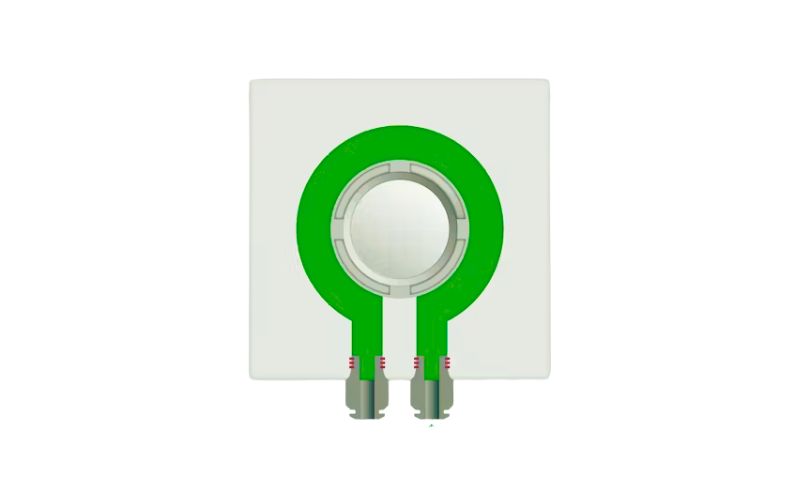
Thermal Analysis
Thermal simulation helps you understand how heat moves through your mold and part during the injection molding process. You can identify hot spots where plastic might cool unevenly, leading to defects like warping or sink marks.
Most simulation software creates color-coded temperature maps showing how heat distributes across your mold. This visual feedback makes it easier to spot problem areas before they cause real manufacturing issues.
With thermal analysis, you can compare traditional cooling channels to conformal designs side-by-side. Studies consistently show that conformal cooling reduces cycle times by 20-40% while improving part quality.
Try simulating multiple cooling cycles to see how your mold performs over extended production runs. This helps predict long-term performance and identify potential failure points.
Flow Simulation
Flow simulation examines how coolant moves through your channels. This helps ensure your design provides consistent cooling without pressure drops or flow restrictions.
You’ll want to check factors like:
- Coolant velocity throughout the system
- Pressure distribution at turns and intersections
- Reynolds number to confirm turbulent flow (which improves heat transfer)
- Potential areas where air pockets might form
Modern simulation tools can automatically suggest improvements to your channel design. For example, they might recommend adjusting diameter in certain sections or modifying turn angles to reduce pressure drop.
You need to use the actual data for your specific mold materials and coolants rather than generic values.
Applications and Case Studies
Automotive Industry
Automotive manufacturers have embraced conformal cooling to produce complex plastic components with better precision and efficiency. When creating dashboard elements, door panels, and under-hood components, conformal cooling channels follow the exact contours of these parts.
Auto parts suppliers decreased cycle times by 22% after implementing conformal cooling in their injection molding process. This resulted in significant production increases for their high-volume parts.
Consumer Products
The plastic parts manufacturer upgraded their traditional molds for pharmaceutical pill bottles using conformal cooling. This change eliminated cooling-related defects and improved production speed.
For electronics housings and appliance parts, conformal cooling channels enable manufacturers to create complex geometries with better surface finishes. This means fewer visible flow lines and sink marks on your products.
Medical Devices
For intricate medical components with slender geometric shapes, innovative “green conformal cooling” systems provide uniform temperature control. This is crucial when you’re producing parts that require extreme precision like surgical instruments or implantable devices.
The pharmaceutical industry uses conformal cooling in molds for drug delivery devices and packaging. The improved cycle times help meet high production demands while maintaining the strict tolerances required for medical applications.
When producing thin-walled medical components, you’ll find that conformal cooling prevents hot spots that could compromise material integrity. This ensures consistent material properties throughout the part – essential for components that may be used in critical medical procedures.
Maintenance Solutions of the Conformal Tooling
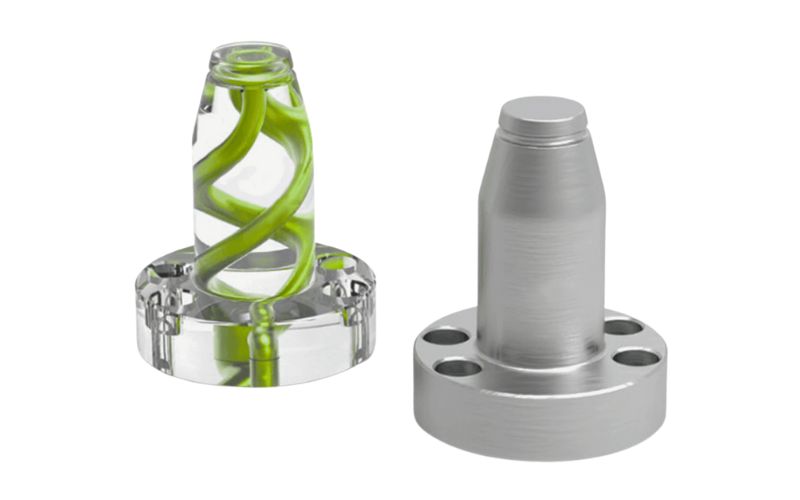
Maintenance and Operational Challenges
Conformal cooling channels are often smaller and more complex than traditional cooling lines, making them prone to clogging and corrosion. These narrow passages can accumulate mineral deposits or debris over time.
For this issue, you can use filtered water systems. Adding rust inhibitors and anti-scaling chemicals to your coolant mixture helps protect the channels.
Access for maintenance presents another challenge. Unlike straight drilled channels, conformal cooling paths can’t be easily cleaned with traditional tools.
Consider implementing preventive maintenance using chemical flushing solutions designed for small channels. Regular pressure testing can also help identify blockages before they cause production problems.
Frequently Asked Questions
What is the cost implications of integrating conformal cooling into a manufacturing setup?
The 3D printing are needed to create these complex channels.
Can conformal cooling be applied to any mold design, or are there limitations?
Conformal cooling works best with parts that have complex geometries or varying wall thicknesses. Simple parts might not justify the added expense.
There are some size limitations based on the manufacturing method used to create the mold. Very small features or channels may be difficult to produce.
The mold design must accommodate the cooling system without compromising structural integrity. Working with experienced designers helps ensure optimal channel placement.

